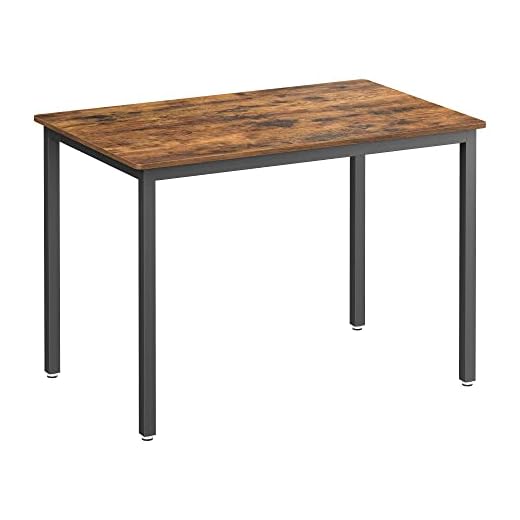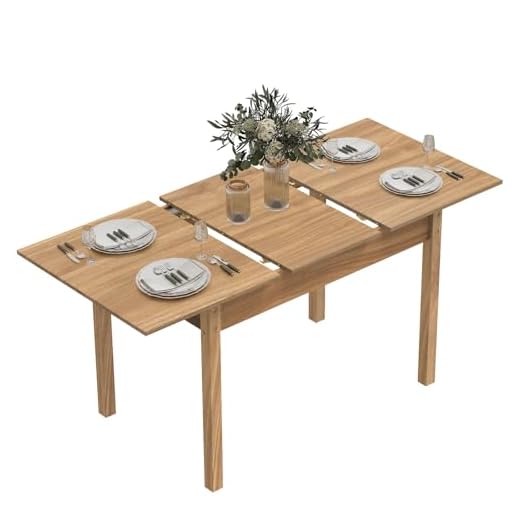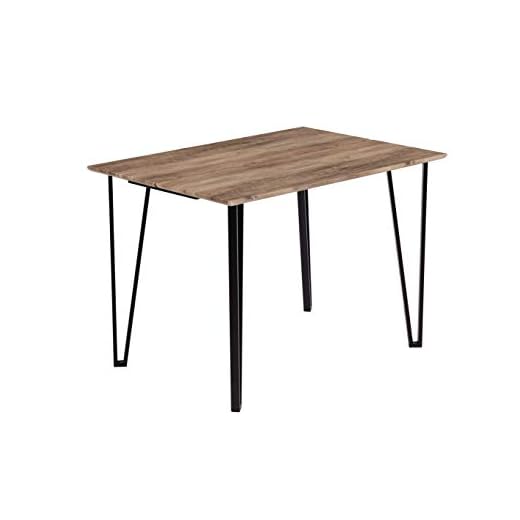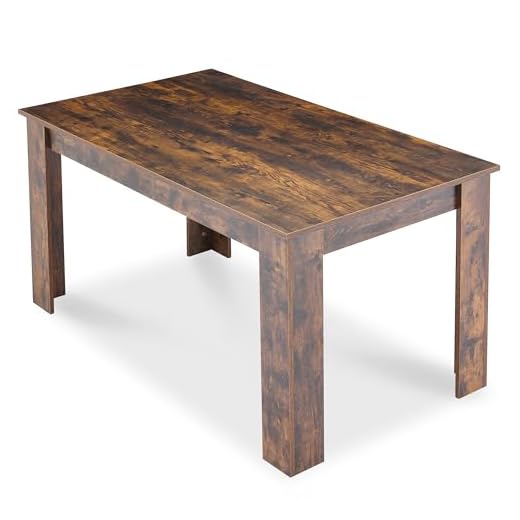Dining tables are the heart of a home, where families gather to share meals, celebrate special occasions, and create memories. Choosing the right dining table is crucial for both functionality and aesthetics. This comprehensive guide will cover everything you need to know about dining tables, including types, benefits, key considerations, a buying guide, pros and cons, usage tips, shopping online, reviews, prices, coupons and discounts, choosing the right one, caring for it, frequently asked questions, and a conclusion.





Types of Dining Tables
Dining tables come in a variety of styles, shapes, and materials to suit different needs and preferences. Here are the main types:
- Rectangular Dining Tables: The most common type, ideal for larger gatherings and providing ample seating. They fit well in most dining rooms and offer a classic look.
- Round Dining Tables: Great for small spaces and promoting conversation, round tables create an intimate dining experience without corners.
- Square Dining Tables: Perfect for square rooms and smaller gatherings, offering an alternative to rectangular and round tables.
- Oval Dining Tables: Combining the benefits of rectangular and round tables, oval tables offer more seating flexibility while maintaining a softer appearance.
- Extendable Dining Tables: These tables can be extended to accommodate more guests, making them versatile for different occasions.
- Drop-leaf Dining Tables: Featuring sides that can be folded down, these tables are excellent for saving space when not in use.
Benefits of Dining Tables
Investing in a good dining table can bring several advantages to your home:












- Central Gathering Point: Dining tables serve as a central location for family and friends to gather, fostering communication and togetherness.
- Versatility: Beyond meals, dining tables can be used for various activities such as homework, games, and crafts.
- Enhanced Décor: A well-chosen dining table can enhance the overall aesthetic appeal of your dining area, adding style and sophistication.
- Durability: Quality dining tables are built to last, providing long-term value and reliability.
- Space Utilization: Dining tables can help optimize the use of space in your dining room or kitchen, making the area more functional and organized.
Key Considerations
When choosing a dining table, consider the following factors to ensure it meets your needs:
- Size: Ensure the table fits comfortably in your dining area, leaving enough space for chairs and movement around the table. Measure the available space to find the right dimensions.
- Seating Capacity: Consider how many people you need to seat regularly and choose a table that accommodates your family and guests.
- Material: Pick a material that suits your lifestyle and maintenance preferences, such as wood, glass, metal, or marble.
- Style: Select a design that matches your home’s aesthetic, whether it’s modern, traditional, rustic, or contemporary.
- Shape: Choose a shape that complements your space and seating arrangement, considering the advantages of each type.
- Functionality: Consider additional features like extendable leaves or storage options that add functionality to the table.
Buying Guide
Purchasing the right dining table involves more than just picking the first one you see. Here’s a detailed buying guide to help you:
- Set a Budget: Determine how much you are willing to spend. Dining tables come in a wide range of prices, so having a budget can narrow down your options.
- Research: Look at different brands and models. Read reviews and compare features to understand what’s available within your budget.
- Visit Stores: If possible, visit physical stores to see and feel the tables, checking for quality and fit firsthand.
- Check Return Policies: Ensure the store offers a good return policy in case the table doesn’t meet your expectations.
- Look for Warranties: A warranty can provide peace of mind, covering any manufacturing defects or issues that may arise after purchase.
Pros and Cons
Before making a purchase, consider the pros and cons of owning a dining table:
Pros:
- Functional Space: Dining tables offer a dedicated space for meals, gatherings, and various activities.
- Aesthetic Appeal: They can enhance the look of your dining area, adding style and elegance to your home.
- Versatility: Many dining tables are versatile, offering additional features like extendable leaves for larger gatherings.
Cons:
- Space Requirements: Dining tables require space, which can be an issue in smaller homes or apartments.
- Cost: High-quality dining tables can be expensive, especially those made from premium materials or with intricate designs.
- Maintenance: Depending on the material, dining tables may require regular maintenance to keep them looking their best.
Usage Tips
Maximize your enjoyment and the functionality of your dining table with these usage tips:
- Keep it Clutter-Free: Regularly clear the table to maintain a clean and inviting space for meals and activities.
- Use Table Mats: Protect the surface from scratches, heat, and spills by using table mats and coasters.
- Balance Decoration and Function: While it’s nice to decorate your table with centrepieces, ensure they don’t obstruct the view or take up too much space during meals.
- Regular Cleaning: Clean the table regularly according to the material’s care instructions to keep it in good condition.
- Adjustable Seating: Use chairs with adjustable heights or cushions to ensure comfortable seating for all guests.
Shopping Online
Online shopping offers convenience and access to a wider range of dining tables. Here are some tips for shopping online:
- Read Reviews: Customer reviews can provide insights into the quality and functionality of the table.
- Check Dimensions: Verify the size of the table to ensure it fits your space and meets your needs.
- Compare Prices: Look at different websites to compare prices and find the best deals.
- Delivery Costs: Factor in delivery costs, especially for larger items like dining tables.
- Secure Payments: Use secure payment methods and check the website’s return policy.
Reviews
Reading reviews from other buyers can help you make an informed decision. Look for reviews that mention build quality, design, ease of assembly, and overall satisfaction.
- Positive Reviews: Highlight the table’s aesthetic appeal, quality of materials, and functionality.
- Negative Reviews: Pay attention to any common issues such as poor construction, difficult assembly, or lack of stability.
- Verified Purchases: Focus on reviews from verified buyers to ensure authenticity.
Prices
The price of dining tables in the UK can vary widely based on factors such as material, brand, and additional features:
- Budget Tables: £100 – £300, often made of basic MDF or lightweight materials with simple designs.
- Mid-Range Tables: £300 – £800, typically featuring better materials like solid wood or metal and offering more sophisticated designs.
- Premium Tables: £800 and above, these tables are often made from high-quality materials and feature intricate designs or custom builds.
Coupons and Discounts
To save on your purchase, keep an eye out for coupons and discounts. Here’s how to find them:
- Seasonal Sales: Look for sales during holidays or end-of-season clearance events.
- Online Discount Codes: Search for discount codes on websites like Groupon or sign up for retailer newsletters for exclusive offers.
- Clearance Sections: Check the clearance sections of online stores for discounted items.
Choosing the Right One
Selecting the perfect dining table involves balancing aesthetics, functionality, and practicality. Consider your specific needs and preferences:
- Dining Room Style: Choose a design that complements your dining area’s décor, whether it’s modern, traditional, rustic, or contemporary.
- Seating Needs: Determine how many people you need to seat regularly and choose a table that accommodates your family and guests.
- Material Preference: Pick a material that suits your lifestyle and maintenance preferences. Wood offers warmth, metal provides durability, and glass adds elegance and sophistication.
- Shape and Size: Ensure the table fits comfortably in your dining area and is the right shape to accommodate your seating arrangement and space.
- Functionality: Consider additional features like extendable leaves or built-in storage options that add functionality to the table.
Caring for Your Dining Table
Proper care can extend the life of your dining table. Follow these tips to keep it in good condition:
- Regular Cleaning: Dust and clean the table regularly according to the material’s care instructions to maintain its appearance.
- Protect the Surface: Use table mats, coasters, and tablecloths to protect the surface from scratches, heat, and spills.
- Material-Specific Care: Follow manufacturer recommendations for specific materials, whether it’s wood, metal, or glass.
- Avoid Direct Sunlight: Prolonged exposure to direct sunlight can fade and damage the table’s finish, so place it away from windows or use curtains to block the sun.
- Inspect Regularly: Periodically check for any signs of wear or damage and address them promptly to maintain the table’s functionality and appearance.
Frequently Asked Questions (FAQs)
- Q: How do I choose the right size dining table?A: Measure your dining area and ensure there is enough space for chairs and movement around the table. Generally, allow at least 90 cm (36 inches) between the table and walls or other furniture.
- Q: What material is best for a dining table?A: The best material depends on your needs and preferences. Wood is durable and classic, metal offers a modern touch, and glass adds elegance and sophistication.
- Q: How can I protect my dining table from scratches and spills?A: Use table mats, coasters, and tablecloths to protect the surface. Clean up spills immediately to prevent damage.
- Q: Are extendable dining tables worth it?A: Yes, if you frequently host guests or need flexibility in seating capacity, extendable dining tables are a practical choice.
- Q: How do I maintain a wooden dining table?A: Regularly dust and clean the table with a wood-safe cleaner. Use coasters and mats to prevent scratches and heat damage. Periodically polish or wax the table to maintain its finish.
Conclusion
Dining tables are an essential part of any home, providing a space for meals, gatherings, and various activities. By considering the different types, benefits, and key considerations, you can make an informed purchase that complements your dining area’s style and meets your needs. Whether you’re shopping online or in-store, take advantage of reviews, compare prices, and look for discounts to get the best deal. With proper care and maintenance, your dining table will serve you well for years to come.
Happy dining!



